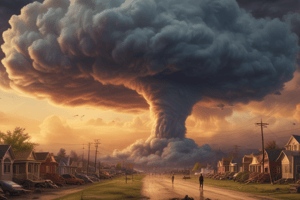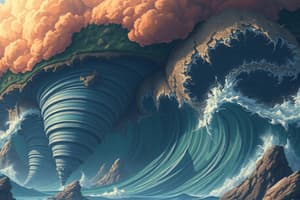Podcast
Questions and Answers
What are hurricanes primarily characterized by?
What are hurricanes primarily characterized by?
- Magma, ash, and gas
- Strong winds, heavy rains, and flooding (correct)
- Lava flows and pyroclastic flows
- Earthquakes and tsunamis
Which hurricane category has sustained wind speeds exceeding 157 mph?
Which hurricane category has sustained wind speeds exceeding 157 mph?
- Category 2
- Category 3
- Category 5 (correct)
- Category 1
What are the primary results of volcanic eruptions?
What are the primary results of volcanic eruptions?
- Earthquakes and tsunamis
- Sustained wind speeds and heavy rains
- Heavy rainfall and flooding
- Explosions, lava flows, pyroclastic flows (correct)
Which natural disaster is associated with Mount St. Helens' eruption in May 1980?
Which natural disaster is associated with Mount St. Helens' eruption in May 1980?
What is a common impact of hurricanes on coastal regions?
What is a common impact of hurricanes on coastal regions?
Which natural disaster devastated Galveston with significant casualties in 1900?
Which natural disaster devastated Galveston with significant casualties in 1900?
What is a common characteristic of tornadoes?
What is a common characteristic of tornadoes?
How do earthquakes occur?
How do earthquakes occur?
Which natural disaster is characterized by water accumulation at ground level?
Which natural disaster is characterized by water accumulation at ground level?
What was the impact of the 2007 Kosi River flood in India?
What was the impact of the 2007 Kosi River flood in India?
Which disaster is known for causing damage to buildings and infrastructure in the United States?
Which disaster is known for causing damage to buildings and infrastructure in the United States?
What is a defining feature of volcanic eruptions?
What is a defining feature of volcanic eruptions?
Flashcards
Tornado
Tornado
A rapidly spinning column of air with intense winds.
Earthquake
Earthquake
Earth's crust breaking, releasing energy along fault lines.
Flood
Flood
Water accumulating at ground level from heavy rain or snowmelt.
Hurricane
Hurricane
Signup and view all the flashcards
Volcanic Eruption
Volcanic Eruption
Signup and view all the flashcards
Natural Disaster
Natural Disaster
Signup and view all the flashcards
Tornado damage
Tornado damage
Signup and view all the flashcards
Earthquake damage
Earthquake damage
Signup and view all the flashcards
Flood impact
Flood impact
Signup and view all the flashcards
Hurricane impact
Hurricane impact
Signup and view all the flashcards
Volcano eruption impact
Volcano eruption impact
Signup and view all the flashcards
Desertification
Desertification
Signup and view all the flashcards
Study Notes
Natural Disasters
Natural disasters occur when natural phenomena have severe impacts on human populations or their environment. These events can range from sudden catastrophes like tornados to slower processes such as desertification. Here, we will explore different types of natural disasters, including tornadoes, earthquakes, floods, hurricanes, and volcanic eruptions.
Tornadoes
A tornado is a rapidly spinning column of air with whirling winds that can reach up to 300 mph (480 km/h). They typically form over land during thunderstorms and can cause significant damage to buildings and infrastructure. In the United States alone, there are around 1,000 tornadoes each year, causing almost $1 billion in property damage annually.
Earthquakes
An earthquake occurs when the earth's crust breaks along fault lines and suddenly releases energy. Depending on the magnitude of the quake, it can cause widespread damage to structures, roads, and utilities. For instance, the Great Hanshin–Awaji earthquake in Japan in 1995 caused nearly 6,500 deaths and destroyed 100,000 homes.
Floods
Flooding happens when water accumulates at ground level due to heavy rainfall, rapid snowmelt, or other causes. This phenomenon affects low-lying areas near rivers, lakes, and coastlines, often leading to loss of life, displacement, and economic hardship. One example is the 2007 Kosi River flood in India, which resulted in the loss of 172 lives and affected more than 4 million people.
Hurricanes
Hurricanes are tropical storms characterized by strong winds, heavy rains, and flooding. The most intense ones can become Category 5 storms, with sustained wind speeds exceeding 157 mph (253 km/h). Although they primarily affect coastal regions, their effects can spread far inland due to torrential downpours associated with these systems. An infamous example is the Galveston Hurricane of 1900, which killed approximately 6,000 people and left another 10,000 injured.
Volcanic Eruptions
Volcanoes are geological features that release magma, ash, and gas into the atmosphere. When one erupts, it can cause massive destruction through explosions, lava flows, and pyroclastic flows. Mount St. Helens was responsible for 57 deaths and approximately $3 billion in damages after its eruption in May 1980.
In conclusion, natural disasters are unpredictable events that pose significant challenges to our societies. Understanding the various forms they take helps us prepare better for their potential impact and minimize losses.
Studying That Suits You
Use AI to generate personalized quizzes and flashcards to suit your learning preferences.




